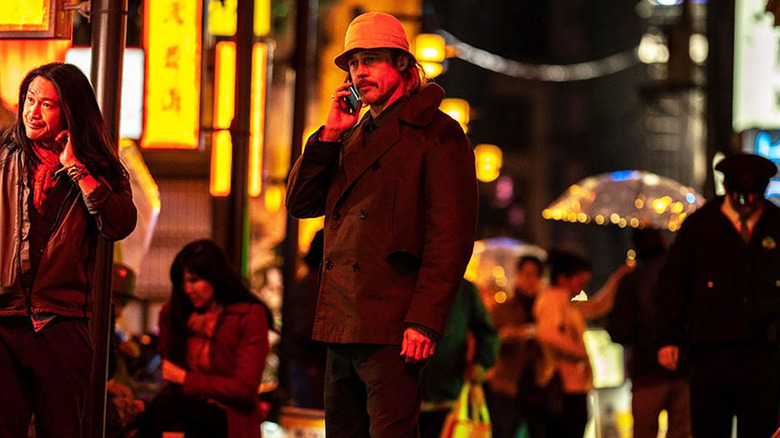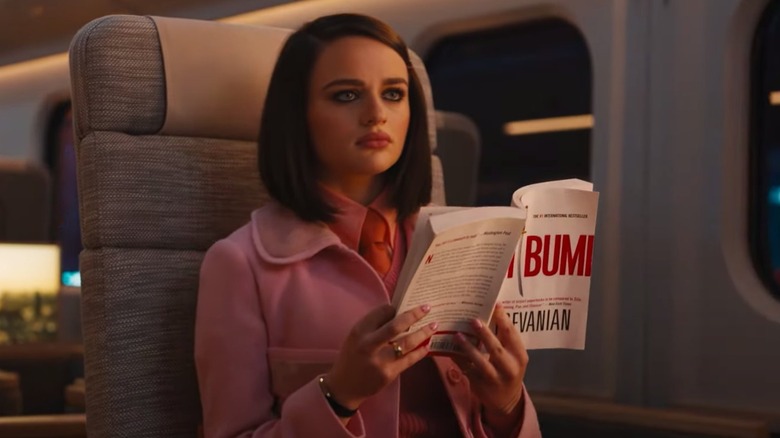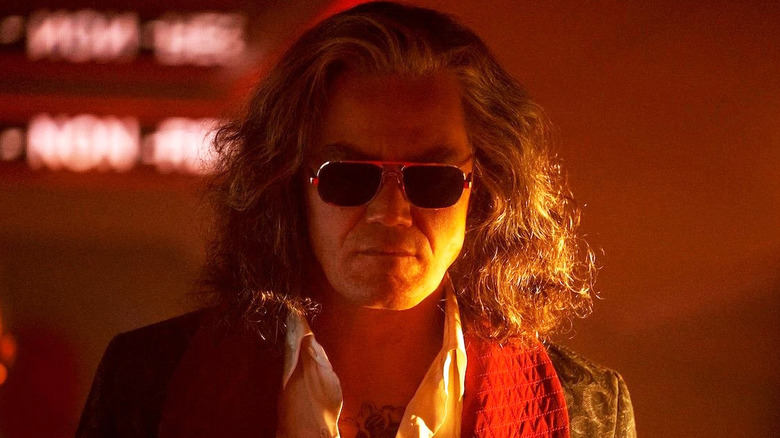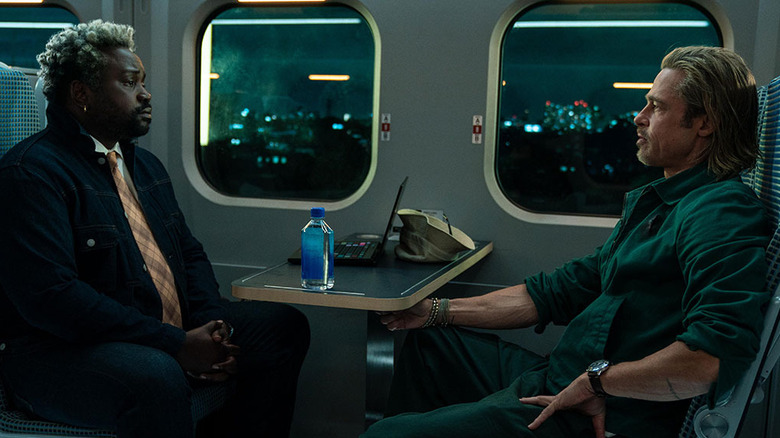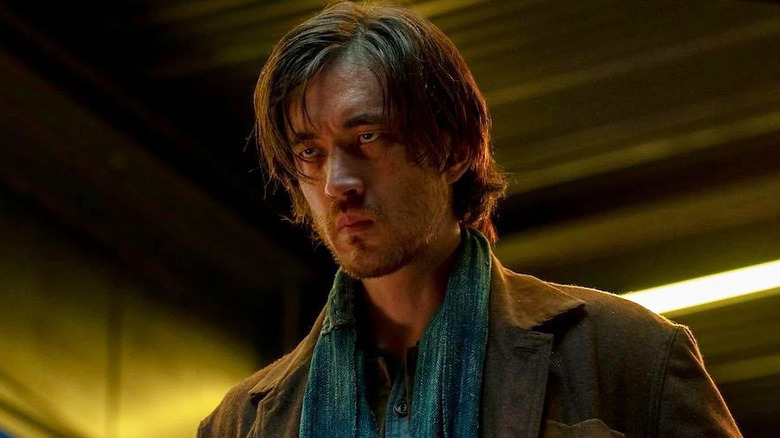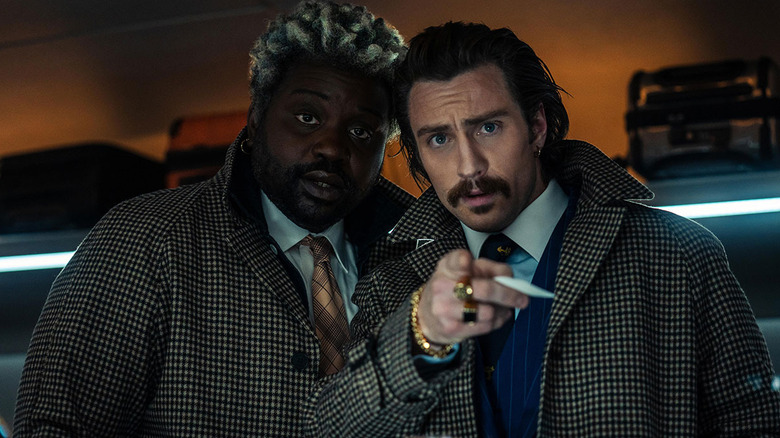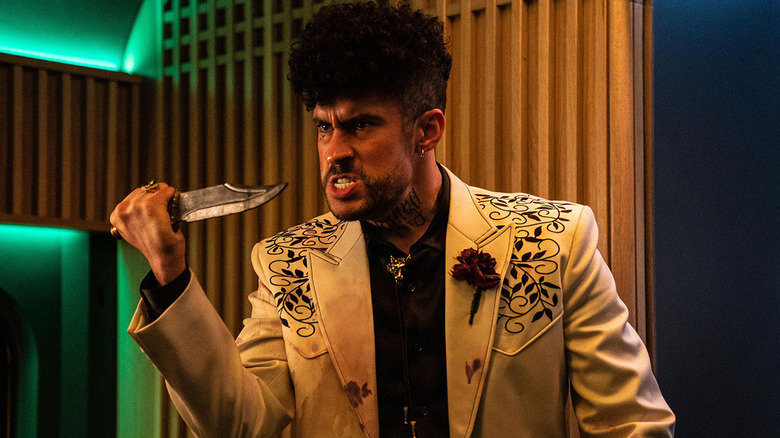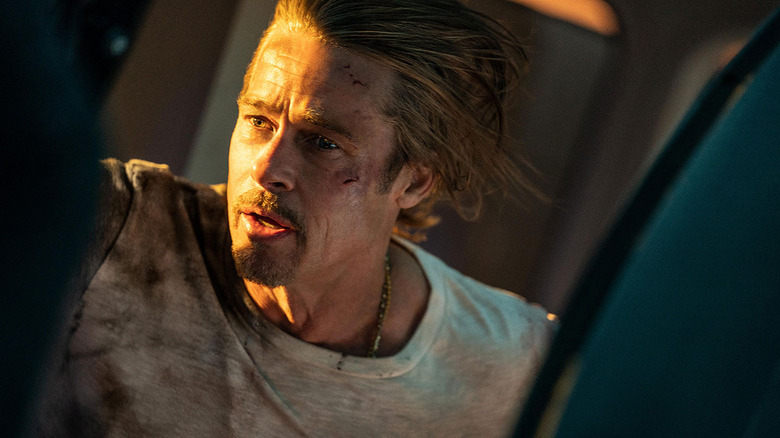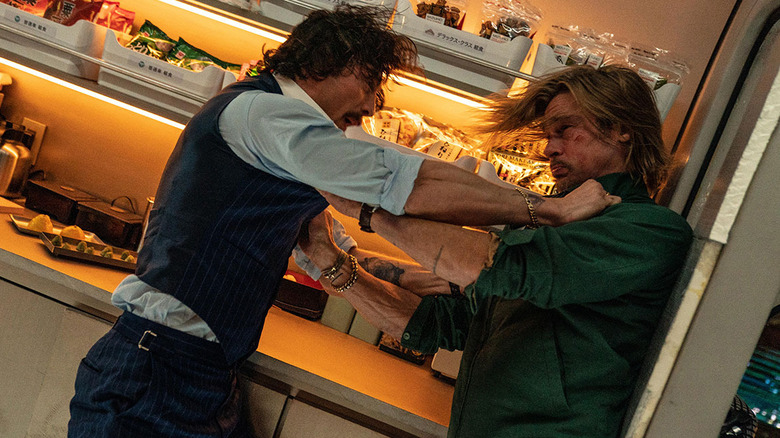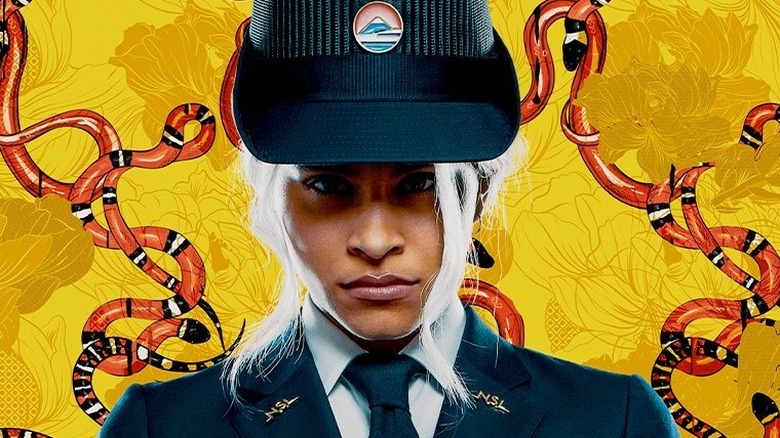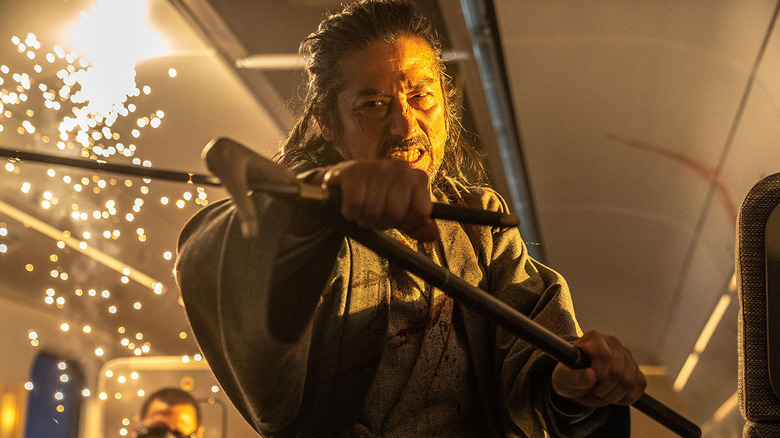10 Most Badass Fight Sequences From Bullet Train, Ranked
Warning: The below article contains spoilers for "Bullet Train."
Imagine the dangerous worlds of "Seven Psychopaths," "Kill Bill," and "Kiss Kiss Bang Bang" colliding, and that'll give you a taste of what's in store with Sony Pictures' "Bullet Train." Starring Brad Pitt in the role of Ladybug, the action-packed neo-noir film fuses situational and quippy comedy with plenty of hand-to-hand combat. Based on Kōtarō Isaka's 2010 novel of the same name, the dark comedy thriller follows Pitt's perpetually unlucky hired gun. After several jobs have left him conflict-adverse, Ladybug accidentally stumbles into a gig that has him caught in the crossfire of many lethal gangsters and vengeance-filled killers. At its heart, "Bullet Train" is a comedy of errors action film that showcases as many sucker punches to its ensemble cast as it does biting comebacks.
Directed by David Leitch ("Deadpool 2"), "Bullet Train" excels most when it zooms in on creative ways to survive (and win) a too close battle on a high-speed train, utilizing props and environmental settings as weapons in a way that harkens back to the comedic fight styling of Jackie Chan. As someone who has practiced martial arts for two decades, I'm delighted to present you with the film's 10 best fight sequences that are incredibly fun to watch unfold — thanks, in part, to the film's steady camerawork and long-panning shots.
10. Prince vs. The White Death
For most of "Bullet Train," the story revolves around the inevitable confrontation between Prince (Joey King) and The White Death (Michael Shannon). The premise leans so much on this fated meeting that it comes as no surprise that the Prince is actually The White Death's daughter. Shockingly, though, their battle — if you can call it that — barely lasts more than a couple of minutes. Despite the film leading the audience to expect that King's character would have some martial arts skills under her belt, she relies on a Russian monologue and a gun to confront her father. The White Death, of course, quickly disarms her.
While it's disappointing that their confrontation ends so quickly, this moment earns a spot on this list for showing how speedy The White Death is with his hands, thanks to stunt double Richard Cetrone. The viewer needs to see this so we can buy into the fact that The White Death requires two yakuza assassins to defeat him. Additionally, Shannon's stillness in this scene and cursory walk demonstrate that this is a seasoned fighter who knows when it's best to save their energy versus strike. Most sparring is about timing and judgement. One hasty move can open you up for an attack. This moment cues us into the fact that The White Death is lethal because he's careful.
9. The White Death's origin story
Michael Shannon's The White Death embodies the shadowy villains of a many assassins-led film mixed with the blade-happy bloodshed of samurai cinema. We're introduced to this killer foe through The Elder's flashbacks, chronicling how he rose to the top of a yakuza gang before murdering them all. The main flashback scene shows The White Death slicing through his former allies with a katana, eventually using a revolver as his new gang does most of the sword-slicing around him. At first, this scene slays. The White Death emerges with a unique mask while moving swiftly and foes are cut like their bodies are butter.
However, the scene relies more on its stylish smoke and heavy rock score than on carving out some time to highlight the film's sword-fighting. The action happens so quickly that its focus is more on showcasing a high kill count around The White Death than sword skills. Also, there's a huge missed opportunity here to utilize Hiroyuki Sanada's The Elder. While the film sets up The White Death and The Elder to be enemies, this scene could have given them their first fight, fueling The Elder's rage. "The Last Samurai" and "47 Ronin" star is a martial artist who is known for fighting with a short and long blade, aka daishō, and this scene would have landed better if they had a one-on-one match done in a continuously panning shot to fully embrace the Akira Kurosawa vibes "Bullet Train" homages.
8. The water bottle's victory
David Leitch showed action fans in "Deadpool 2" how much comedy there can be found in props-led action. His work in "Bullet Train" is no different, and it's best demonstrated by how the film makes a water bottle part of the film's ensemble. Like the other film's characters, the water bottle receives a title card, an origin story, and technically sees a piece of the action, too. The bottle rolls right into Yuichi's hand at a pivotal moment, landing like a fighting assist. Yuichi then uses the water bottle as a weapon, throwing it at The White Death's head to knock him out, giving him and The Elder a chance to regroup.
Of course, this is funny but it also harkens back to the ways that Jackie Chan-starring films often saw him using ordinary items for defense and offense. In his hands, a chair could be a shield. A basket could disarm a swordsman and produce knocked out people. The "Bullet Train" director spoke to /Film about the choice to homage Chan, noting, "When you look at Jackie [Chan] and a lot of those characters that he's had where he is sort of the underdog and he's trying to survive and he's using the props in this fun Buster Keaton-esque way, it was a no-brainer to lean into that and the homage to Jackie's choreography." This move gets creativity points, even if does take away from the film's potential to showcase more fights.
7. Lemon vs. Yuichi Kimura
I'm still not entirely over how little Andrew Koji's Yuichi Kimura character gets to fight on-screen in "Bullet Train." Koji has studied Shaolin kung-fu and taekwondo, skills that shine gorgeously in the HBO Max series "Warrior," but are seldom used in the David Leitch film. When Yuichi faces off against Lemon, the script makes it more a battle of wits than brawn. Yes, punches are thrown. Shots are fired. But the scene relies on how Prince can convince Lemon that Yuichi is the real villain, hiding the fact that she's holding him hostage.
Still, it's always a joy to watch how fluidly Koji moves, so this one-on-one battle earns a mid-spot. He's so light on his feet that his spins and ducks to get out of the way land effortlessly and clearly on-screen. It's hard to capture quickness and clarity of movement on film. Truth be told, most martial arts' poses need to be held longer for the camera to catch the order of movements without confusing the audience. Strikes and blocks are slowed down, too. But the moves — and the pauses that come with them — need to feel tense enough that it seems like things are happening lightning fast. As a performer who has extensive experience with choreographing fight scenes and stuntwork, Koji excels at this difficult balancing act.
6. Tangerine and Lemon's 17 kills
"Bullet Train" has no shortage of intriguing characters running through its high-speed train on a killer mission. But of the entire ensemble cast, Tangerine (Aaron Taylor-Johnson) and Lemon (Brian Tyree Henry) steal the show. To his credit, Zak Olkewicz's screenplay doesn't delve too much into the backstory of the pair. However, we know just enough about their relationship and work life to draw some absurd and compelling conclusions. Lemon and Tangerine are brothers who go by the code-name the Twins — a kind of visual gag that lands best within the deadpan world of neo-noir. Together, the pair take on jobs as hitmen.
To give us a taste of who the Twins are, "Bullet Train" shows us a flashback of the two killing 17 people back-to-back. The sequence plays like the finale of a moment we've yet to see, full of car explosions, bullets flying, and a fish hook impaling a man's skull. Little time is wasted connecting how one action spirals into another, creating a hysterically brutal domino effect. Great action scenes arrive when you can see the connection between an attack and its result, and this moment highlights that amazingly well. Still, it relies too much on gunfire, which earns it a middling spot on the list. Guns aren't as interesting to watch as a surefire way to kill lessens fighting tension. If this scene had more hand-to-hand combat with gunfire — like Chad Stahelski's "John Wick" franchise — it would have been fantastic.
5. Wolf vs. Ladybug
Brad Pitt's Ladybug does not have an easy go of it in "Bullet Train." No matter where he goes on this high-speed train, he walks straight into danger. One of his first big fights is with Bad Bunny's Wolf character, a Mexican gangster who is seeking revenge for someone murdering his entire wedding party, including his wife. Unfortunately, it turns out that Brad Pitt was at the wedding on a different job, but the Wolf thinks that Ladybug had a hand in the assassinations, too. Of course, a lethal battle ensues throughout several train cars.
This moment is the first time we get a true taste of Pitt's fighting talents. Although he does have a stunt double for the film, Kyle Mclean, director David Leitch confirmed that Pitt did 90 percent of his own stuntwork for "Bullet Train." That commitment on Pitt's part paid off, as Ladybug's quick dodges and quick-thinking use of nearby props to defend himself feels both realistic and delightfully heightened. Hands down, the best part about this battle is watching just how long Pitt can defend himself with train-car objects (like a briefcase), and keep the movement comedic and tense simultaneously. The end of the fight comes quickly with Ladybug dodging a knife throw and redirecting it with quick precision. Narratively, that makes sense as Ladybug has several more battles to fight. But the electric chemistry between the two makes it hard to not wish the segment lasted a couple of minutes longer.
4. Lemon vs. Ladybug
Technically, Lemon and Ladybug face off a handful of times in "Bullet Train," but the best part about their dueling is within their quiet car meetup. The blocking in this scene is both comedic and action perfection, utilizing a lot of chair-swapping antics and up-close hand-to-hand combat between bouts of stillness. Again, the stillness cues the viewer into the tension building between the two. There's an energetic urgency as Brad Pitt and Brian Tyree Henry alternate between who has the quickest hands and who can go back to "normal" whenever an annoyed passenger — portrayed by a surprise Nancy Daly cameo — tells them to "shh!"
Their timing is tight. Out of every fight in this film, this one feels the most like the Hong Kong cinema vibes the film so clearly loves. It's absurd that they're quietly trying to kill each other in a full train car, but it works, thanks to Pitt, Henry, and their respective stunt doubles, Kyle Mclean and Nathaniel Perry. However, it leans more into defensive moves as a comedy that sometimes undercuts the fight. The setup lends itself so well to sneaking in more Wing Chun-style hand blocks and strikes. At one point, Ladybug blocks a punch by using The Son's dead body, a move that fuses laughs and fast-paced technique in a way that only director David Leitch can pull off, and is still admirable.
3. Tangerine vs. Ladybug
Ladybug and Tangerine fight brutally on more than one occasion, but their battle in the snack car is my favorite. At this point in the film, you can tell that the characters are tired and frustrated. They transition into mostly boxing-style jabs to the face and leaning their entire weight into throwing bodies across countertops. The fight is not pretty in the best of ways. Tangerine is holding nothing back, charging into action without paying any mind to block or shield himself from Ladybug hitting him in the head with packaged food items. Tangerine is a brawler that's well past reasoning and that emotion comes across in how he's fighting, which is a wonderful characterization to see.
Similar to the quiet train car scene, this one also peppers in comedic relief by having one of the train's crew members, played by "The Boys" star Karen Fukuhara, interrupt them to reload the snack cart. Quietly, the two buy an overpriced water bottle from her and take a break before butting heads again. Some of the moves are a bit repetitive, so although it's a great scene, it's not the best in a film that, for the most part, ups its ante and martial arts with each new contender.
2. Ladybug vs. The Hornet
This scene gave me chills! Brad Pitt's physicality here is tremendous as he platforms off and on countertops while defending himself against Zazie Beetz's The Hornet. Everyone moves speedily in this film, but this boasts the quickest and trickiest sequences to master. For the most part, the two characters are in constant movement. They redirect what's coming at them by sliding into a new direction or using a cupboard as a temporary shield, but never once do they pause. Each lunge has an immediate pushback, and each hit leads to another blow. Their rhythm is dynamic and fluid. One misstep would ruin the fight as the camera is 100 percent on them in mostly wide shots. That shooting style shows us how each move unfolds, never relying on a cutaway to hide an error. (The outtakes for this sequence must be painfully hysterical.)
However, what earns it a top spot on this list is how the scene uses its needle as a weapon. The trickiest part of this segment is when The Hornet tries to kill Ladybug with venom, and Ladybug has to redirect a stabbing motion back towards her with it feeling like one motion. The quickness required to pull that off beat-wise is a lot and shows how much time the stars, their doubles, and director David Leitch put thought into orchestrating these moves.
1. The Elder & The Father vs. The White Death
Despite lamenting that there isn't more Hiroyuki Sanada and Andrew Koji fight scenes in "Bullet Train," the film does deliver them a gorgeous sequence in its off-the-rails finale. As Ladybug and Lemon deal with a train car full of henchmen, The Elder, Yuichi, and The White Death battle it out. This fight sequence is the kind of two-sword fighting styling that I wanted to see, and it very much feels like director David Leitch was just waiting to deliver the samurai cinema veteran's final form for the film's big finish. Of course, it pays off! It's Sanada!
What works best, though, is how believable the blocking is. Despite the train exploding into sheets of metal, the choreography stays grounded in the real world. A fight between two against one is always hard to stage, as the viewer wants to know (consciously or not) why the two aren't overcoming one fighter. You have to create believable diversions and hard-hitting punches, and space all this sequencing out in a way that feels organic. Otherwise, you run the risk of it looking like a video game where nearby fighters patiently and unrealistically wait to attack. "Bullet Train" excels at balancing all of these factors in its final showdown, giving room for both Koji and Sanada's martial arts experience to shine on the big screen. Their precision with steps and careful attention to the distance between one another is unparalleled.
